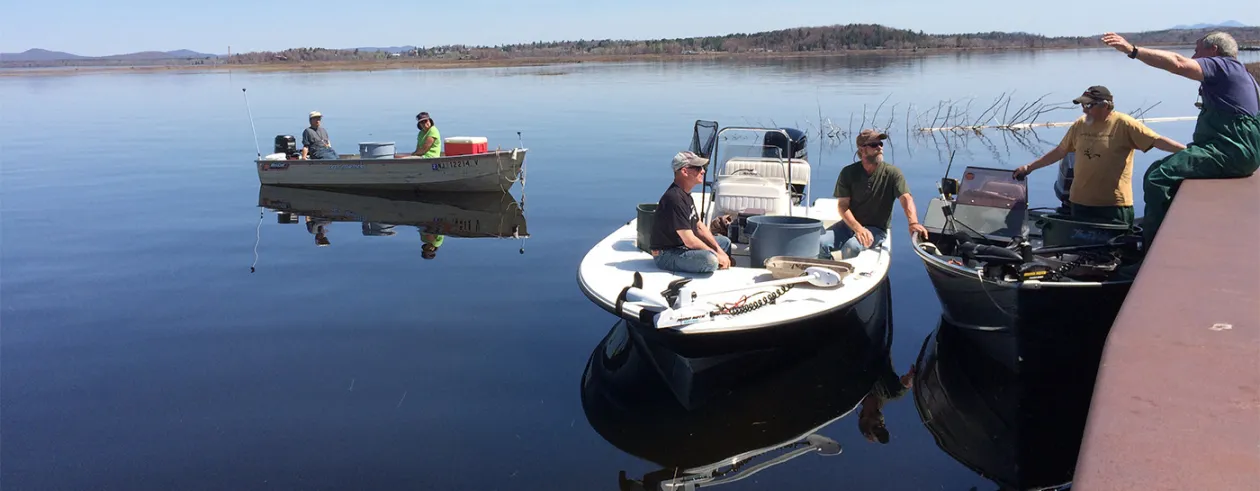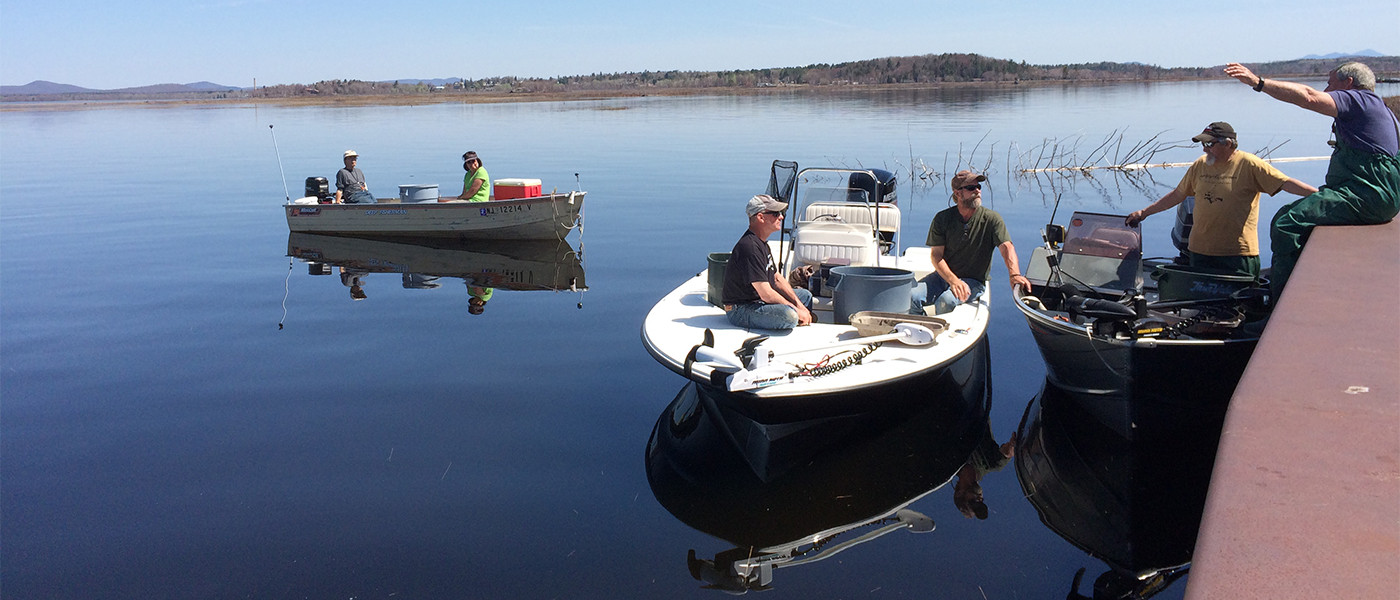
For the Angler in You
Finding a Home in Tupper Lake
Last week I had the unique opportunity of tagging along as the NYS Department of Environmental Conservation (DEC) and countless volunteers all rallied together to stock Big Tupper Lake with 3,000 landlocked salmon and 10,000 lake trout. For early May, you couldn’t have asked for a more beautiful day to be out on the water. As the boats gathered at the Tupper Lake Boat Launch waiting for the guests of honor (the fish) to arrive, you could feel the excitement in the day build. And, that was when fish stories started to fly. After all, you can’t expect to find that many anglers together on the water and not have this to happen, can you?
Fish Stocking Big Tupper Lake
Ever wonder what it is like to see thousands of fish being released into a lake? TV fishing personality, Don Meissner, was kind enough to join us to help capture the story behind the the annual fish stocking that was taking place. Check out this video to learn more about the fish, the stocking effort & the magic of the day as it unfolds… (DON’T MISS when the fish really start moving at about 6:30 minute into the video!)
For more information & photos on Fish Stocking in Tupper Lake, check out this recent blog.
10 Fishing Hacks & Tips From Don Meissner

After spending a gorgeous day on the lake with a dozen or so fishing enthusiasts (and a whole lot of fish), I left inspired to get out there and cast a line for myself. But without all of the high-tech fishing equipment, my question really is: where do I start? I just witnessed for myself that fishing can come with a whole lot of cool, but sometimes expensive, fishing gear. So to combat my anxiety about spending a boat-load of money (pardon my pun... couldn't resist), I asked Don to share some of his fishing tips and hacks with me. Here's a bit of the great insider information he provided me with.
1. Don't have a fish finder? Use the wind!
Wind can be your friend. There are three ways in which the wind can effect how the fish bite:
- Once the wind comes up, it creates a current in the water which will not only stimulate the fish to look for bait, but will drive the bait into structured areas.
- Wind will bring temperature changes; it will bring warm water in, or colder water in, either one of which will initiate the fish to bite.
- Wind, in creating current and disturbing the surface of the water, will cause visibility of the fish toward anything approaching them to change. So, often in calm water, fish will look at a bait for a long time and not hit it because they can tell that it is false. But the wind will cause the bait to be detracted and will sometimes stimulate a strike.
One final note, that old saying holds true: "When the wind's in the east, the fish bite the least - when the wind's in the west, the fish bite the best."
2. Marshmallows are not just for toasting

Bait fishermen often have the problem of continually snagging, especially if they are fishing from shore. Here's an affordable tip to help you keep your worms floating in the current where they look natural to the fish and also to keep you from snagging on the bottom. Take a long shank hook and then take a small marshmallow - you can even cut up a larger one to the size you want - run the marshmallow to the eye of the hook. Then when you run your worm onto the hook after you have put the marshmallow there you have done a couple of things: the marshmallow will serve as as bobber and allow the worm to float above the bottom and it also might be a smell attractor, because fish like sweet things, just like we do.
3. Get artistic
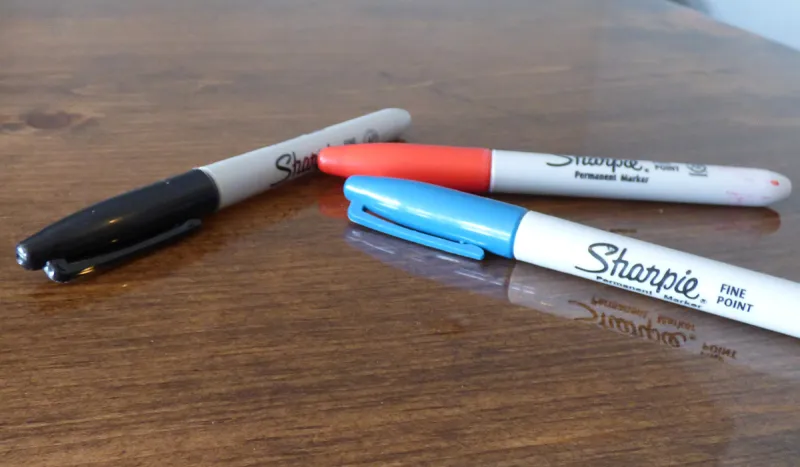
Colored, fine point sharpies are great for fine tuning and repurposing broken swim baits, crank baits, and other lures to get those extra bites. When you tear the head off of a swim bait or toad and think it is no longer usable, don't throw it away. Cut it in half and use the back end as a trailer for a spinner bait or buzz bait. Get creative, take a sharpie along and draw bigger eyes on your plugs, or draw a red strip down it to make your plug look like it might be bleeding, or put spots on it - a lot of times fish orient towards spots because they think it's eyes. Fish will often target any of their prey by going for their eyes.
3.5 - Blood!
This leads to the next thing... blood. Anything red can trigger fish to strike. A tip that a lot of anglers go to is using red hooks, or taking their hooks off and replacing them with the same size red hook. The hook will lie under the bait and look like the bait is bleeding. Just like sharks, any fish can be triggered into striking if they think that something is wounded and will be easy prey. Using red markers on your plugs can have a similar effect.
4. Accessorize with nail clippers
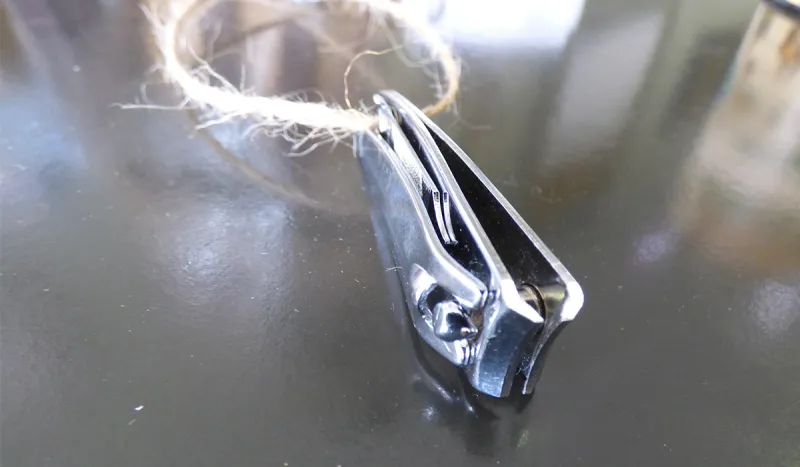
Every angler should have a pair of nail clippers hanging around your neck or in your pocket. Rather than using your teeth to cut the line in a hurry, wearing a pair of nail clippers around your neck will make them easily accessible, especially if you have stepped away from your tackle box.
5. Get your hands wet!
All species of fish are covered in some sort of slime. That slime serves as a protector - it is almost like their immune system. Once you remove that slime while you are handling the fish, you put that fish in danger because now they are prone to infections. So, it is critical that you be aware of this slime. If it is catch-and-release - which is becoming very popular today - you should avoid using dry hands on the fish. Always immerse your hands in water before handling the fish because that will help keep that slime from coming off on your dry skin.
6. Forgot your bait? Find your own...
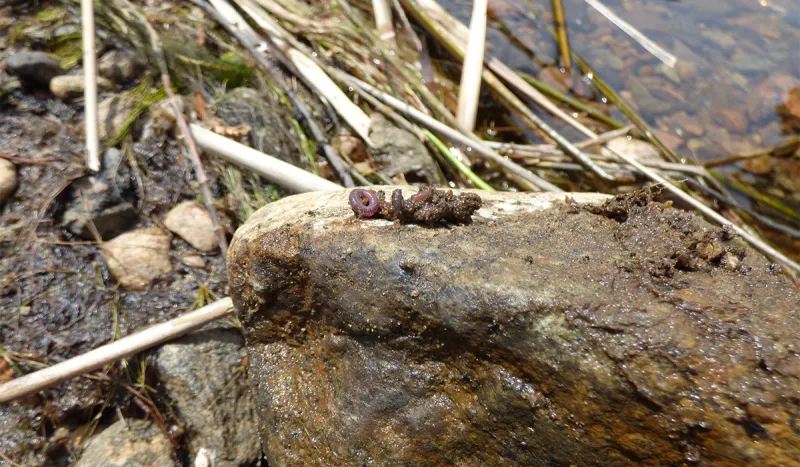
Oftentimes when you go fishing, you may find your bait is dead or you run out of bait - then you wonder how you are going to fish? It's sometimes easy to find natural bait along a stream or pond. Worms can be found in soil that has a grassy top; avoid looking for worms in sandy soil or where there are a lot of pine trees as the dirt will be too acidic. But it is easy to find worms, especially along the bank, where the bank drops off. Use your hands and remove the dirt and there are usually worms in the first few inches of the soil. Another place to look is for logs or stones that are on the ground. These insulate the soil and provide moisture. Lift the rock up slowly and you will usually find a few worms or slugs under these rocks. Salamanders in particular will lay under logs. Trout and bass in particular love salamanders. Grasshoppers, crickets, and crayfish also make great bait and can be found near your fishing hole.
7. Get the inside scoop
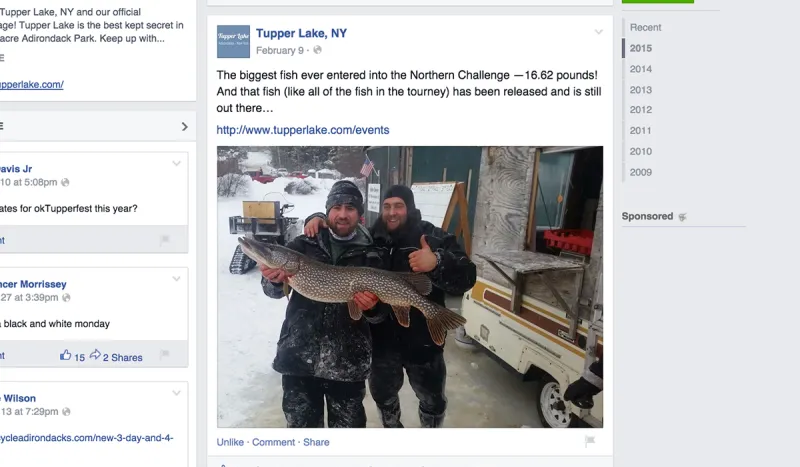
Anytime you are fishing in a new area there are a few ways to find fishing information... Find a list of local bait or tackle shops, owners are always talking to their customers, and most fishermen like to brag about the fish they caught and often where, and how, they were caught it. Another is social media. People go on platforms like Facebook to brag about their catches. They post pictures and they even sometimes have video that describes where and how they caught the fish. Often they will even make it easier by tagging the area that they are fishing at when they post the information.
Stay Organized!
8. Well, this is EZY
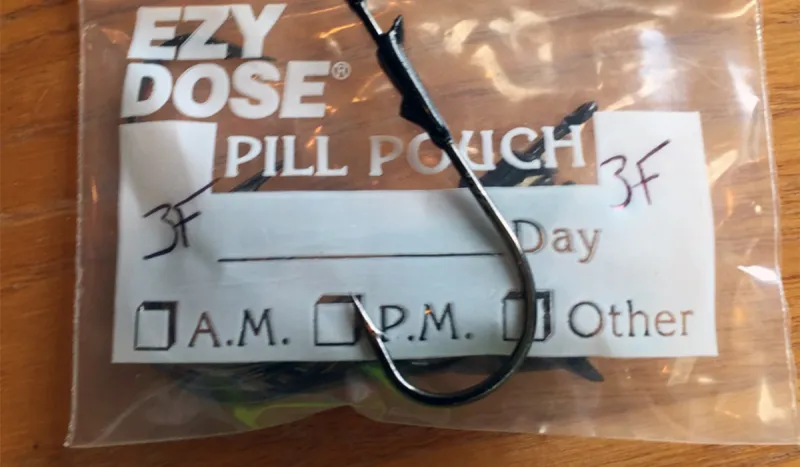
Pill pouches can be used to organize countless hooks and to keep them dry. Bleeding of soft plastic bait is also a huge issue. If you put a yellow one in with a white one, or a blue one in with a red one, the colors will bleed together almost instantly - especially if they are in the sun or warmth. Using pill pouches can help keep the colors separate.
9. Another use for your daughter's bracelet bands
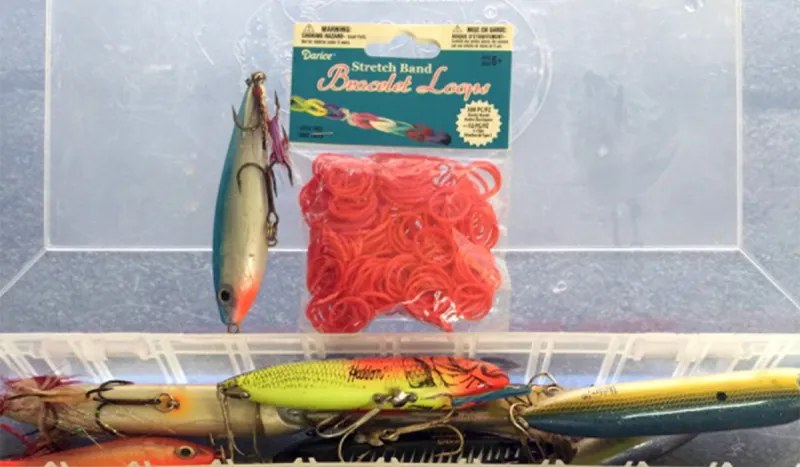
Bracelet bands, or those small rubber hair ties that you find at the dollar store, can also help you keep your tackle box organized. Use them to secure hooks together and keep them from tangling. It also doubles the amount of lures you can put in a box.
10. PVC Pipes are for more than plumbing!
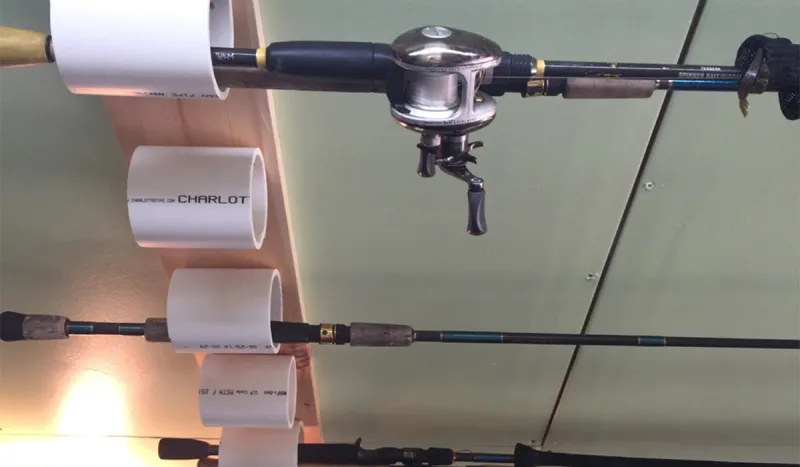
Keep your fishing rods up and out of the way by mounting short lengths of cut PVC to a board on your ceiling. This will not only help you store your rod, but may also prevent it from potentially being broken.
Come Hack the 'Dacks!
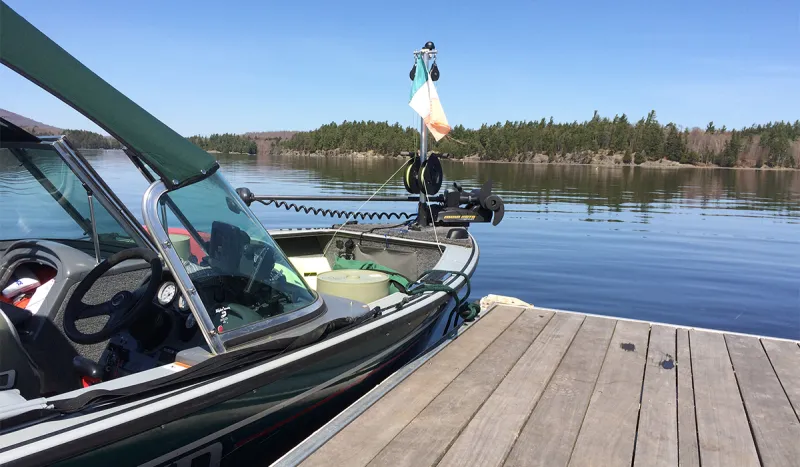
Now that Don was kind enough to share these tips with me, I thought that I would pass them along to you and invite you to come put them to use. You don't need top-of-the-line equipment! With some simple ingenuity, you will not only be getting your line wet, but hopefully you will be going home with a catch of your own.
Got fishing tips and hacks? Share them with us in the comments below.
Check out these related 'Dack Hacks:
13 Hacks for doing LP on a budget
10 outstanding car camping hacks
DIY guide to beginner bushwhacking
Hiking off the beaten path: from peaks to ponds
Planes, trains, automobiles, boats, bikes... if it goes, get it here
